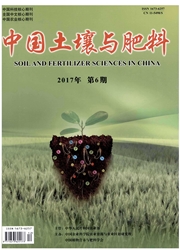

 中文摘要:
中文摘要:
In order to reveal the impact of various fertilization strategies on carbon(C) and nitrogen(N) accumulation and allocation in corn(Zea mays L.), corn was grown in the fields where continuous fertilization management had been lasted about 18 years at two sites located in Central and Northeast China(Zhengzhou and Gongzhuling), and biomass C and N contents in different organs of corn at harvest were analyzed. The fertilization treatments included non-fertilizer(control), chemical fertilizers of either nitrogen(N), or nitrogen and phosphorus(NP), or phosphorus and potassium(PK), or nitrogen, phosphorus and potassium(NPK), NPK plus manure(NPKM), 150% of the NPKM(1.5NPKM), and NPK plus straw(NPKS). The results showed that accumulated C in aboveground ranged from 2 550–5 630 kg ha–1 in the control treatment to 9 300–9 610 kg ha–1 in the NPKM treatment, of which 57–67% and 43–50% were allocated in the non-grain organs, respectively. Accumulated N in aboveground ranged from 44.8–55.2 kg ha–1 in the control treatment to 211–222 kg ha–1 in the NPKM treatment, of which 35–48% and 33–44% were allocated in the non-grain parts, respectively. C allocated to stem and leaf for the PK treatment was 65 and 49% higher than that for the NPKM treatment at the both sites, respectively, while N allocated to the organs for the PK treatment was 18 and 6% higher than that for the NPKM treatment, respectively. This study demonstrated that responses of C and N allocation in corn to fertilization strategies were different, and C allocation was more sensitive to fertilization treatments than N allocation in the area.
 英文摘要:
英文摘要:
In order to reveal the impact of various fertilization strategies on carbon(C) and nitrogen(N) accumulation and allocation in corn(Zea mays L.), corn was grown in the fields where continuous fertilization management had been lasted about 18 years at two sites located in Central and Northeast China(Zhengzhou and Gongzhuling), and biomass C and N contents in different organs of corn at harvest were analyzed. The fertilization treatments included non-fertilizer(control), chemical fertilizers of either nitrogen(N), or nitrogen and phosphorus(NP), or phosphorus and potassium(PK), or nitrogen, phosphorus and potassium(NPK), NPK plus manure(NPKM), 150% of the NPKM(1.5NPKM), and NPK plus straw(NPKS). The results showed that accumulated C in aboveground ranged from 2 550–5 630 kg ha^–1 in the control treatment to 9 300–9 610 kg ha^–1 in the NPKM treatment, of which 57–67% and 43–50% were allocated in the non-grain organs, respectively. Accumulated N in aboveground ranged from 44.8–55.2 kg ha^-1 in the control treatment to 211–222 kg ha^–1 in the NPKM treatment, of which 35–48% and 33–44% were allocated in the non-grain parts, respectively. C allocated to stem and leaf for the PK treatment was 65 and 49% higher than that for the NPKM treatment at the both sites, respectively, while N allocated to the organs for the PK treatment was 18 and 6% higher than that for the NPKM treatment, respectively. This study demonstrated that responses of C and N allocation in corn to fertilization strategies were different, and C allocation was more sensitive to fertilization treatments than N allocation in the area.
 同期刊论文项目
同期刊论文项目
 同项目期刊论文
同项目期刊论文
 Greenhouse gas emissions and stocks of soil carbon and nitrogen from a 20-year fertilised wheat-maiz
Greenhouse gas emissions and stocks of soil carbon and nitrogen from a 20-year fertilised wheat-maiz Soil organic carbon sequestration in upland soils of northern China under variable fertilizer manage
Soil organic carbon sequestration in upland soils of northern China under variable fertilizer manage Evaluation of the CENTURY Model Using Long-Term Fertilization Trials under Corn-Wheat Cropping Syste
Evaluation of the CENTURY Model Using Long-Term Fertilization Trials under Corn-Wheat Cropping Syste Contributions of wheat and maize residues to soil organic carbon under long-term rotation in north C
Contributions of wheat and maize residues to soil organic carbon under long-term rotation in north C Changes in Organic Carbon Index of Grey Desert Soil in Northwest China After Long-Term Fertilization
Changes in Organic Carbon Index of Grey Desert Soil in Northwest China After Long-Term Fertilization Modelling and Predicting crop yield, soil carbon andnitrogen stocks under climate change scenarios w
Modelling and Predicting crop yield, soil carbon andnitrogen stocks under climate change scenarios w 期刊信息
期刊信息
